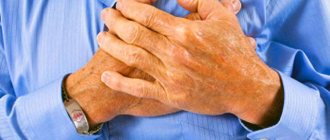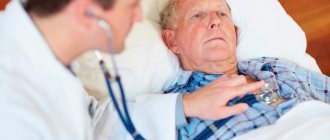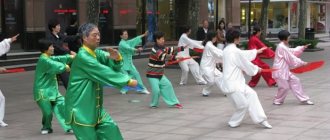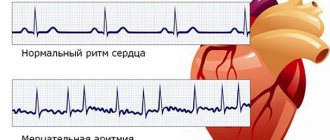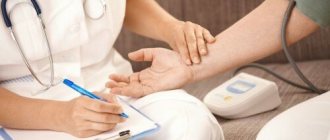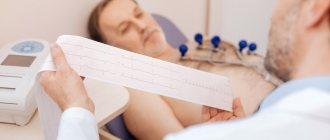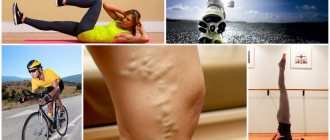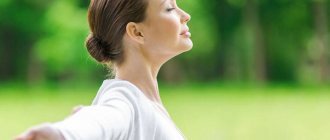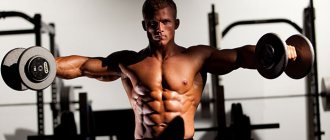Cardiac arrhythmia is a disruption of its normal activity, manifested in a disorder of the rhythm, frequency and sequence of contraction of this organ. Thus, an increase in heart rate is called tachycardia.
Bradycardia is defined as a slow heart rate and pulse less than 60 beats per minute.
Extrasystole is an untimely contraction of the heart, or its individual parts, which affects the overall function of the organ. With atrial fibrillation, the heart contracts chaotically, which leads to organ hypofunction and negative changes in the general condition of the body.
Physical exercises for cardiac arrhythmia in any of its manifestations help restore the functioning of the heart muscle and are prescribed in the complex treatment of these pathologies.
Arrhythmia: symptoms, causes
Arrhythmia as a disease manifests itself in the deviation of the heartbeat rhythm from the norm to a greater extent (tachycardia) or to a smaller direction (bradycardia).
ATTENTION!
This disease can become one of the first signs of severe pathologies, which will further develop and worsen. In addition, arrhythmia can lead to problems and disruptions in the functioning of the heart, up to its temporary stop.
The main symptoms of arrhythmia are:
- constant weakness and fatigue;
- headaches and dizziness;
- attacks of pain, pressure in the chest area;
- feeling of strong heartbeat;
- sudden acceleration or deceleration of heart rate (attacks);
- the appearance of shortness of breath and increased breathing;
- fainting and unconscious states.
To begin treating arrhythmia, you should find out the causes of the pathology. These include:
- frequent stressful and nervous situations;
- prolonged or excessive use of medications and traditional medicine;
- severe intoxication (poisoning) of the body;
- presence of heart disease (in particular, coronary disease and heart failure);
- diabetes mellitus of any degree;
- abuse of smoking, alcohol, caffeine;
- problems and pathologies of the circulatory system;
- history of traumatic brain injury.
REFERENCE!
Most often, arrhythmia manifests itself during a stressful state of the body, which can be noticed by the acceleration (in most cases) or slowdown of the heartbeat.
If symptoms of the disease occur, you should undergo an examination and begin treatment. First of all, you need to do special physical exercises.
Breathing exercises and their effect on the heart
Breathing exercises for diagnosed cardiac arrhythmia contribute not only to the restoration of heart rhythm, but also to the improvement of the entire body due to its saturation with oxygen. This happens due to the fact that at the moment of inhalation, the bronchi expand, and the heart ventricles eject blood: the right atrium into the pulmonary veins, the left atrium into the aorta. At the moment of exhalation, blood is actively absorbed by both atria, which normalizes the performance of the heart muscle.
One of the effective methods of treating arrhythmia through breathing exercises is to perform the following list of exercises:
- Perform half squats (if you are in good health - full squats) - from 10 to 20 times.
- Extend your right hand to the side, while with your left you need to pinch your left nostril and take a slow breath.
- Repeat the steps, changing your right hand to your left.
- Sit on a chair and repeat the previous exercise (steps 2 – 3).
- Take 3 to 4 slow, full inhalations and exhalations.
- Repeat the set of exercises with inhalations and exhalations, while stretching your lips, as if pronouncing the letter “u”.
Other types of physical activity
For cardiac arrhythmia, physical exercise should be moderate, but daily. Their intensity is increased gradually so that the body can adapt. At first, this may be a short walk with mandatory heart rate monitoring. Then you can alternate walking with running at a slow pace.
When heart rhythm disturbances occur, swimming is very effective, but without stress, which can be done in a pool or in calm natural bodies of water. Riding a bicycle or an exercise bike is not contraindicated. In winter, you can make ski trips on flat slopes without descents or ascents.
(
2 ratings, average: 5.00 out of 5)
Exercise and its effect on the heart
IMPORTANT!
Physical exercises in the presence of cardiac arrhythmia should be performed only after a complete diagnosis, examination and consultation with a doctor.
All this is necessary to determine the patient’s physical fitness and health status and to determine the possibility or impossibility of performing exercise therapy (therapeutic physical education).
Physical activity affects the restoration of heart rhythm and normalization of blood circulation. At the same time, working on exercises requires regularity and constant monitoring of the patient’s health by a doctor.
Basic exercises that are recommended for patients with arrhythmia:
- Swimming to maintain muscle tone, in particular the heart.
- Walking outdoors or indoors walking in place.
- Run at a comfortable speed.
- Cycling allows you to actively work most muscle groups, this promotes proper breathing rhythm.
If it is not possible to exercise outdoors or in other places designated for this (swimming pool, gym), it is recommended to do therapeutic exercises at home, including the following points:
- Walk in place for 5 minutes. Breathe through your nose and swing your arms to the sides while walking.
- Perform body turns to the sides 10 to 15 times.
- Perform side bends 10 to 15 times. Please note that you need to bend over while exhaling, and lifting your body while inhaling.
- Make circular movements with your pelvis alternately in both directions 10 – 15 times.
- Swing your arms back and forth 10 to 15 times.
REFERENCE!
It is recommended to exercise (a full set of exercises or home exercises) before the first meal or 2 to 3 hours after it. If your health condition improves, you should increase the number of exercise sets and walking pace.
Arrhythmia after physical activity: what to do?
A similar condition occurs in 19-60% of cases of uncontrolled activities. The likelihood of occurrence increases in proportion to age: in people over fifty years of age it occurs in half of the episodes. Stress-induced ventricular arrhythmias manifest themselves in 36-50% of coronary heart disease in the form of extrasystoles (VCs), tachycardia (VT), and fibrillation (VF).
The most common disorders after physical activity are sinus arrhythmia (respiratory) or atrial fibrillation.
The comparative frequency of occurrence of violations is presented in the table:
| All types of PVCs, % | Frequent PVCs, % | PVCs of high gradations (pairs, triples, VT, VF), % | |
| Healthy people | 19-38 | 3-11 | 2-6 |
| Patients with coronary heart disease | 38-50 | 23-37 | 6-15 |
The patient is concerned about:
- confusion;
- dizziness;
- dyspnea;
- chest discomfort or pain.
It is necessary to immediately stop the training, ensure that the patient is in a semi-sitting position and have access to fresh air, and give him forty drops of Corvalol (Valoserdina, Valocordina) to drink with water.
In the near future after the attack, they plan to visit a doctor for examination and treatment.
Prevention of complications
- aerobic exercise takes no more than two hours a week;
- uniform loads every day;
- after intense exercise they rest;
- Before increasing dynamics, the muscles are warmed up.
Various techniques
In order for therapeutic exercises and gymnastics to help with arrhythmia, you need to select a complex based on the type and stage of the disease according to the recommendations of the attending physician. Thus, when diagnosing atrial fibrillation, excessive loads in general are strictly prohibited, and starting exercises is allowed only in a hospital setting under the direct supervision of a specialist. Other types of pathology are not prohibitions for therapeutic exercise with a properly selected set of exercises.
According to Bubnovsky
Exercises to restore normal heart rhythm according to Bubnovsky’s method include squats involving all the muscles of the legs and buttocks. The main requirement when performing them is to squat while inhaling and stand up while exhaling. At this time, the body distributes blood evenly from the heart muscle throughout the body, which eliminates heart fibrillation.
During such exercises, special attention should be paid to the physical preparation of the leg muscles, placing the maximum amount of load on them if possible. In such cases, performing squats in compliance with the correct exercise technique can replace cycling, running, and walking in terms of the degree of impact on the body.
ATTENTION!
You should not overdo it during exercise, you should not overstrain your muscles and bring the body to complete exhaustion.
You should start classes with 5–10 squats in 1 approach in the complete absence of physical training and from 15–20 in the presence of it. The number of approaches in the first stages of such physical education should not exceed three. Over time, you should increase them, as well as the total number of squats.
It is also recommended that Bubnovsky take heart rate measurements before and after exercise and compare the readings with the norm. Thus, it is possible to check the results of the treatment.
According to Strelnikova
The sinus type of arrhythmia, although one of the safest for health, also requires treatment using breathing exercises. In this case, exercises using Strelnikova’s method are especially effective. Exercises allow you to normalize your heart rate, and in the first stages of arrhythmia, cure it completely.
Like other breathing exercises, Strelnikova’s technique is aimed at activating the cardiovascular and circulatory systems and requires regularity and a gradual increase in load. The exercises should be performed in this order:
- Standing straight, take 5 to 8 shallow breaths. Walk a short distance, taking a short breath with each step. It's worth starting with 8 steps.
- Standing with your arms down and your back straight, you need to clench your fists as you inhale and unclench them as you exhale. It is recommended to perform the exercise at least 6 times with a break.
- Standing with your hands on your waist, lower your hands down as you inhale and return them to their place as you exhale. For the first stages of training, it is recommended to perform the exercise 10–12 times with a break.
- Standing straight, with your legs apart at shoulder level, you need to inhale and tilt your body down and spread your arms to the sides. As you exhale, you need to return to the original position. The exercise should be repeated 12–15 times with breaks.
Regular performance of this set of exercises allows you to quickly get rid of a low or high heart rate. But it should be remembered that deterioration in well-being during exercise requires temporary cessation and a reduction in the pace of their implementation in the future.
According to Buteyko
The Buteyko exercise technique for the treatment of arrhythmia is one of the most common and popular methods of getting rid of this pathology. It is based on training the correct breathing rate, which affects the heart rate. This complex includes the following exercises:
- Standing straight, take shallow breaths, hold your breath for 5 seconds and long exhales. In this case, you need to breathe through your nose, and your chest and stomach should remain motionless while inhaling. It is recommended to repeat the exercise 10 times.
- In a standing or sitting position, inhale, gradually filling the diaphragm and chest, then, emptying them in the reverse order, slowly exhale. At least 10 repetitions of the exercise are also required.
- Alternately take 10 full breaths from each nostril. During breaks between them, you should perform a light massage of the nose.
- Pull your stomach in, take a full breath and hold your breath for 5 - 7 seconds, then exhale slowly. It is recommended to repeat the exercise 10 times with a break after each approach for 5 seconds.
- Take 12–15 exhalations and inhalations for 2–3 seconds.
Active breathing exercises using the Buteyko method will help strengthen the whole body as a whole and improve the functioning of the heart in particular.
Breathing exercises
If arrhythmia occurs after exercise, it is recommended to perform breathing exercises. Physical therapy not only provides disease prevention, but also reduces the risk of complications. The technique includes the following:
- The patient does a half-squat and extends one arm to the side. Pinch one nostril with your left and inhale slowly. Then they change and do the same. The frequency of repetitions is set by the doctor depending on the presence of tachycardia, high blood pressure, fibrillation and other reasons. Such gymnastics is not recommended for a small child.
- Then the patient makes breathing movements while sitting on a chair. Physical exercises are not indicated at this stage. With one hand, you need to pinch one nostril to the bridge of your nose and slowly inhale air. They try to exhale quickly. After this, do the same with the other nostril.
- Slowly take in a deep breath of air and gradually exhale.
- At the last stage, repeat the breathing movements from the third point. At the same time, they try to stretch their lips “into a tube.”
The advantage of properly performing gymnastics is the enrichment of oxygen in the blood and tissues of the whole body. The patient independently controls breathing and movements of the diaphragm while doing the exercise.
Yoga and its effect on the heart muscle
One of the “softest” methods of getting rid of arrhythmia is therapeutic yoga.
IMPORTANT!
The main thing during classes is breathing technique. All inhalations and exhalations should be performed exclusively through the nose so that the body has the opportunity to actively saturate itself with oxygen to normalize the heart rate.
It is also recommended to monitor the technique and speed of the exercises: movements should be smooth and correctly performed.
Basic exercises:
- Take the lotus position: place your palms on your heels, draw in your stomach as much as possible while inhaling, leaning forward. Stay in this position for 2 - 3 seconds, then exhale smoothly and return to the starting position.
- Lie on your back with your legs spread apart. Grab your ankles with your hands as you inhale and release them as you exhale.
- Lie on your back. Lift your head, arms and legs off the floor as you inhale and return to their original position as you exhale.
It is recommended to repeat the exercises 5–10 times, picking up the pace with each subsequent session. For treatment, a yoga session twice a week is sufficient.
Exercise therapy in the treatment of arrhythmia
Exercises in the exercise therapy complex, intended for patients with arrhythmia, have not only a healing purpose. This is a gymnastics complex with a strictly dosed load for a specific patient, which takes into account the state of his health, the severity of the disease and the period of development of the disease.
Example exercises in a lying position:
- Flexion and extension of the legs at the ankle joints.
- Flexion and extension of fingers.
- Abduction of arms bent at the elbows. Move your elbows to the sides - inhale, extend your arms along your body - exhale.
- Inhale, extend your arms along your body, palms up. Exhale – raise your arms and reach your knees with your palms, raising your head and tensing.
- Alternately sliding your feet along the bed without lifting them from its surface. Breathing is smooth, without tension.
- Turns with knees bent at the legs, now to the right, now to the left. Breathing is smooth and spontaneous.
- Alternately abducting the right arms and legs to the side, then the left. At the same time, turn your head in the direction of abduction of the limbs.
- Alternately bending and straightening your legs at the knees.
- Lowering and raising your arms up: on inhalation - up, on exhalation - down.
Sitting on a chair:
- Press against the back of the chair. Hands on knees. Taking a deep breath, raise your arms, bent at the elbows to the shoulders. As you exhale, return to the original position.
- Rolling from heel to toe and synchronously clenching and unclenching your fingers.
- Inhaling, raise your arms up, exhaling, lower them down.
- Sliding your feet along the floor without lifting them from its surface.
- Sitting on the edge of a chair and inhaling, move your right arm and left leg to the sides. As you exhale, lower your arm and bend your leg at the knee. Do the same on the other side.
- Hands along the body, alternately lift the left, then the right shoulder. Breathing is smooth and relaxed.
- Inhaling, spread your arms to the sides, exhaling, use your hands to pull the leg bent at the knee towards your stomach and return to the starting position. Do the same for the other leg.
- Sitting on the edge of a chair, place your hands on your belt and take a deep breath. As you exhale, pull your elbows and shoulders inward.
Starting position standing:
- As you inhale, stretch and clasp your hands. As you exhale, lower your arms.
- Tilt the body to the sides while simultaneously abducting the legs in the same direction. Hands raised up.
- Bend your elbows at chest level and spring your arms back.
- Smooth body rotation left and right.
- Inhale with your arms raised up. Lean forward and reach your knees with your hands - exhale.
- Swing your legs forward and backward. Breathing is voluntary.
- Inhale, squat with your arms extended forward and exhale.
Perform all exercises no more than 10 times, monitor your well-being, breathing, and heart rate.
Contraindications
Before starting physical therapy, it is important to make sure that there are no contraindications to this type of therapy. These include:
- mental disorders and pathologies;
- chronic stage of tachycardia;
- pregnancy period (2nd and 3rd trimesters);
- diseases of arthrosis;
- exacerbation of chronic diseases;
- attacks of heart disease, in particular angina pectoris;
- the presence of heart defects, acute heart failure;
- acute gastrointestinal diseases (ulcers, gastritis);
- pathologies of the circulatory system;
- chronic and pathological diseases of the liver and kidneys;
- thyroid diseases;
- hypertension;
- presence of aneurysm, vascular diseases.
To establish the absence or presence of contraindications, it is imperative to undergo a full clinical examination under the supervision of specialists.
Gymnastics and exercises as arrhythmia prevention
In order to prevent the development of arrhythmia and its transition to severe pathological conditions, it is recommended to carry out preventive measures based on therapeutic exercises and exercises. They are also able to protect against deviations in heart rate in general.
Exercises for preventive purposes can be chosen the same as for the treatment of arrhythmia. Movements when working muscles must correspond to the technique of performing each specific exercise.
REFERENCE!
Particular attention should be paid to breathing during exercise: it should not be too slow or fast, and there should also be no shortness of breath.
It is recommended to focus on rotations and tilts of the body, running exercises and walking. The main thing is to use all the muscles of the body and choose the right pace of exercise.
Useful exercises to strengthen the myocardium
In diseases of the cardiovascular system, it is the loads that can increase the resistance of the myocardium to oxygen starvation that bring benefits. These include walking, running, swimming, dancing. Breathing exercises have a similar effect on the heart muscle. Methods for carrying it out may differ, but the most important rule is that the exercises must be performed at an individual, comfortable level.
First aid for arrhythmia
The method of restoring heart rhythm using breathing is based on the fact that a measured rhythm of inhalation and exhalation, which a person can control, normalizes the rhythm of contractions of the heart muscle. Therefore, any option with counting the duration of respiratory movements helps with arrhythmia.
To do this, you can inhale for 2 - 3 counts and exhale for 4 - 6 counts. In this case, you need to be in a sitting position with a straight back. It is recommended to gradually stretch your inhalations and exhalations, focusing on your sensations.
After mastering this exercise, the following type of pulmonary exercises is recommended to prevent attacks:
- Left hand behind back.
- The right hand is located near the face.
- Close your right nostril with your right thumb.
- Inhale through the left nostril.
- Close the left nostril with your ring finger and exhale through the right nostril.
After 8 - 10 breathing cycles, you need to change hands. The duration of the first lesson should not exceed 2 - 3 minutes, then you can slowly increase it. The duration of inhalations and exhalations is determined by comfortable sensations.
For cardiac aneurysm
The use of any load for training, even breathing, with an aortic or cerebral aneurysm, is possible only after consulting a doctor, since stress can provoke intense internal bleeding and death.
If there is a small and stable aneurysm or an operation has been performed to remove this vascular defect, then the doctor may allow you to do gymnastics, including breathing. In this case, any low-intensity and slow movements with simultaneous inhalation and exhalation are indicated:
- spread your arms to the sides - inhale, hug yourself by the shoulders with them - exhale;
- with the pelvis stationary, turn the chest to the right - inhale, return to the starting position - exhale;
- in a position lying on your back, inhale with your stomach for 2 counts, raising the abdominal wall; for 4 counts, exhale, drawing in your stomach.
Watch the video about doing exercises for the heart and their benefits:
httpv://www.youtube.com/watch?v=embed/aNUu4Fhvkts
After operation
From the second day, with an uncomplicated postoperative course, patients begin breathing exercises under the guidance of a doctor to prevent congestion in the lungs. To do this, it is recommended to spend 5-6 times a day for 5 minutes:
- exhale through closed lips (movements like when blowing out a candle);
- inflating balloons or rubber toys;
- exhaling air through a straw into a glass of water.
After 5-6 days it is allowed to sit on the bed and walk within the ward. At this time, breathing exercises are carried out in an expanded mode. Recommended:
- deep belly breathing with accentuated exhalation,
- smooth stretching of the exhalation length,
- inhale for 3 counts and exhale, and then 2 more short exhalations.
With tachycardia
To slow down your heart rate you need maximum relaxation. This can be achieved by changing the ratio of the duration of inhalation and exhalation, as well as by pausing after exhalation. In the first lessons, the ratio of these phases is 3:5:2.
Every day they are increased by 1 count, if discomfort appears, they are stopped until a stable result is obtained, and then you can continue to stretch each breathing movement. If at first it is difficult to breathe like this, then after 3-4 cycles they return to normal breathing; after its restoration, it is recommended to extend the lesson.
To improve blood vessels
To normalize vascular tone and increase performance, the following exercise is performed: after a normal (non-forced) inhalation, you need to exhale sharply and briefly, while drawing in your stomach as you exhale. This is followed by a passive inhalation and a sharp exhalation.
Do 10 cycles of the right nostril with the left one closed, change sides, also take 10 inhalations and exhalations, then with both nostrils 15 times.
